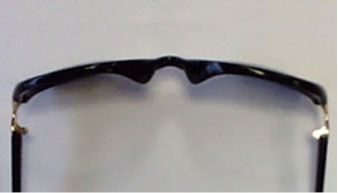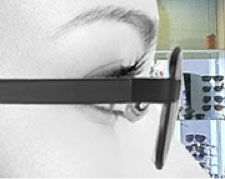 |
Opticians have the rare opportunity to combine fashion with function and technology. No other profession allows for this kind of creativity. It comes with a huge responsibility: to know eyeglass fashion, to be familiar with the latest technology in eyeglass lenses, to be able to explain fashion and function and to advise and assist in the selection of the perfect pair of eyeglasses.
It starts with the Rx analysis. What frame is suitable for what prescription? A skilled optician takes an "eyeglass history." What are the patient's previous eyeglass experiences? What worked well? What did not work out? What kind of frame did they like best?
And then come the most important questions: What are the visual requirements for the new glasses? How should they feel? What is important for the look and design of the frame?
If the patient desires a larger, bold plastic frame and has a small bridge, the optician can explain the benefits of plastic frames with nose pads.

If the patient has a very small distance between eyes and ears, the optician may advise to select a frame with a metal temple that can be custom fit in length to avoid long, unsightly and uncomfortable temple ends behind the ears.
It is critical for the optician to be imaging the final product. What are the glasses going to look like when they are finished? Will they be comfortable? How are they going to hold up? Will the final product match the patient's expectation?
It is apparent that it takes an educated, experienced optician to assist with this difficult process. Any patient that is serious about the comfort and performance of eyeglasses should not expect to achieve satisfaction with the purchase of eyeglasses over the internet.
Equal consideration needs to be placed on the bench alignment of eyeglasses as the last step of the final inspection.
Start with the Bridge
Check for "x-ing", Make sure lenses are coplanar, Check for frontal alignment, Make nose pads even.
The Eyewire
Check for rolling, Look for Pressure points, Make sure the barrels are closed and Make sure the eyewire follows the bevel.
The Endpiece
Temples should be square with front. (X axis), Temples should lay flat. (Y axis) and Temples should fold well (Z axis).
The Temples
Must butt well at hinge, Temple may be curved and 40mm bend for temple tip is standard.
When the optician presents the new eyeglasses to the patient, they need to be clean, accompanied by the appropriate eyeglass case and preferably in a dispensing tray that is different from the lab trays. "You can never change first impression", this also applies to the presentation of the new eyewear to the patient.
After the initial AHs and OHs the optician puts the glasses on the patient and proceeds with the final adjustments starting at the bridge.
Nose Pad Alignment
There are three primary nose pad angles: Vertical, Frontal and Splay or Transverse.
The Vertical Angle is usually between 10° and 15°.

Frontal Angle
The bottom of the nose pad should flair outward conforming to the patient's nose, about 20°.

The amount of Splay Angle needed depends on the angle created between the front and back of the patient's nose.

Face Form and Pantoscopic Tilt
Face form, or parabolic angle, is the amount of curve formed between the frame and the face at the 180° plane. It is a gentle wrap conforming to the patient's face to allow for maximum visual field and least amount of back surface reflections.

Pantaoscopic tilt is formed when the lower eye wire is closer to the patient's face than the top of the frame. A 10° to 12° tilt is desirable and will optimize visual acuity

The Fitting Triangle
A well-fit frame will come into physical contact with the wearer at only three points: the bridge of the nose, on each side of the head including behind each ear. These three points form a triangle known as the fitting triangle.

And lastly, after asking permission to touch the patient's head, the optician will adjust the temples behind the ears. Two points are important here: the over-the-ear bend and the into the head adjustment.
The location of the over-the-ear bend should be placed just beyond the point where the temple makes its last physical contact with the top of the ear. A good over the ear fit will let gravity do its work. The temple will lie close to the contours of the ear without pressing against them.
The final consideration for achieving a comfortable fit is the into-head adjustment. The temple is supposed to follow the contour of the bone behind the ear (the mastoid), touching, but not applying pressure. There should also be no pressure on the soft tissue on the back of the ear. With a proper temple bend, the end of the temple should fall about one half to two thirds down the length of the ear.
The patient will be delighted with the new eyeglasses and the outstanding job performed by the optician.
What has happened here is much more than the sale of a pair of eyeglasses—a relationship has been formed. The patient trusts the optician to be a vision specialist and will return for more eyeglasses and refer friends and family.
 |
As a professional development coach Maggie provides education workshops that focus on leadership and personal engagement. Her time management course has inspired many participants to think outside the box, apply newly acquired knowledge and achieve extraordinary results.
Maggie's enthusiasm for opticianry is inspiring and her keen business sense paired with excellent communication skills make her a highly sought after motivational speaker. www.opticalsuccess.com












